Solar eclipse of November 11, 1901
| Solar eclipse of November 11, 1901 | |
|---|---|
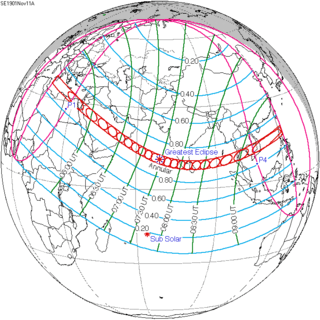 Map | |
| Type of eclipse | |
| Nature | Annular |
| Gamma | 0.4758 |
| Magnitude | 0.9216 |
| Maximum eclipse | |
| Duration | 661 sec (11 m 1 s) |
| Coordinates | 10°48′N 68°54′E / 10.8°N 68.9°E |
| Max. width of band | 336 km (209 mi) |
| Times (UTC) | |
| Greatest eclipse | 7:28:21 |
| References | |
| Saros | 141 (17 of 70) |
| Catalog # (SE5000) | 9284 |
An annular solar eclipse occurred on November 11, 1901. A solar eclipse occurs when the Moon passes between Earth and the Sun, thereby totally or partly obscuring the image of the Sun for a viewer on Earth. An annular solar eclipse occurs when the Moon's apparent diameter is smaller than the Sun's, blocking most of the Sun's light and causing the Sun to look like an annulus (ring). An annular eclipse appears as a partial eclipse over a region of the Earth thousands of kilometres wide. Annularity was visible from the Italian island Sicily, the whole British Malta (now Malta), Ottoman Tripolitania (now Libya), Egypt, Ottoman Empire (parts now belonging to Cretan State in Greece, Israel, Jordan and Saudi Arabia), Emirate of Jabal Shammar (now belonging to Saudi Arabia), Aden Protectorate (now belonging to Yemen), Muscat and Oman (now Oman), British Raj (the parts now belonging to India, Andaman and Nicobar Islands and Myanmar), British Ceylon (now Sri Lanka), Siam (name changed to Thailand later), French Indochina (the parts now belonging to Cambodia, southern tip of Laos and southern Vietnam, including Phnom Penh), Bombay Reef in the Paracel Islands, and Philippines.
Related eclipses
Solar eclipses 1901-1902
This eclipse is a member of a semester series. An eclipse in a semester series of solar eclipses repeats approximately every 177 days and 4 hours (a semester) at alternating nodes of the Moon's orbit.[1]
| Solar eclipse series sets from 1901-1902 | ||||
|---|---|---|---|---|
| Descending node | Ascending node | |||
| 136 | May 18, 1901 Total |
141 | November 11, 1901 Annular | |
| 146 | May 7, 1902 Partial |
151 | October 31, 1902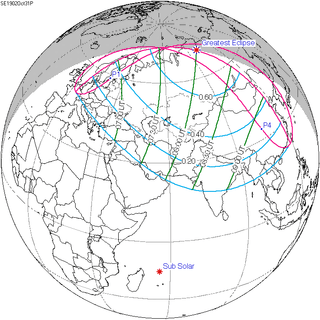 Partial | |
Saros 141
Solar Saros 141 repeats every 18 years, 11 days and contains 70 events. The series started with partial solar eclipse on May 19, 1613. It contains annular eclipses from August 4, 1739 through October 14, 2460. There are no total eclipses in this series. The series ends at member 70 as a partial eclipse on June 13, 2857. [2]
| Series members 17–28 occur between 1901 and 2100 | ||
|---|---|---|
| 17 | 18 | 19 |
 November 11, 1901 |
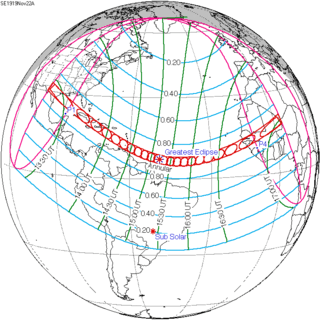 November 22, 1919 |
 December 2, 1937 |
| 20 | 21 | 22 |
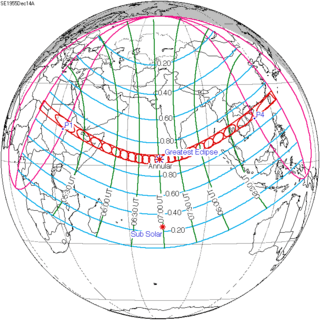 December 14, 1955 |
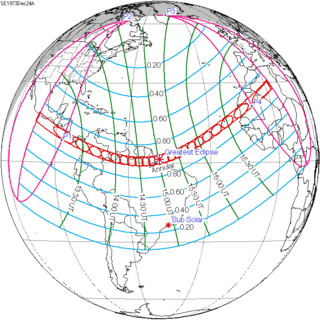 December 24, 1973 |
 January 4, 1992 |
| 23 | 24 | 25 |
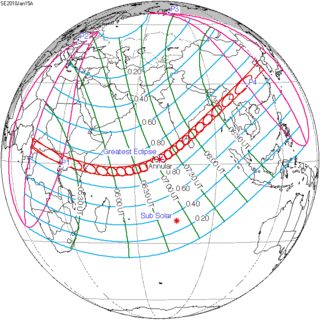 January 15, 2010 |
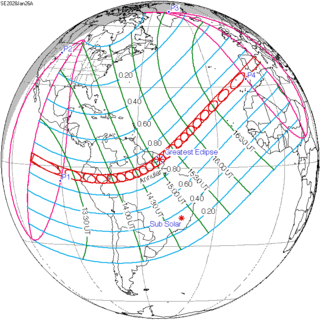 January 26, 2028 |
 February 5, 2046 |
| 26 | 27 | 28 |
 February 17, 2064 |
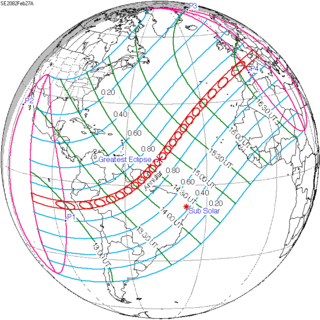 February 27, 2082 |
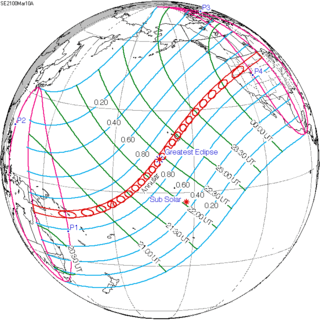 March 10, 2100 |
Notes
- ↑ van Gent, R.H. "Solar- and Lunar-Eclipse Predictions from Antiquity to the Present". A Catalogue of Eclipse Cycles. Utrecht University. Retrieved 6 October 2018.
- ↑ "NASA - Catalog of Solar Eclipses of Saros 141". Eclipse.gsfc.nasa.gov. Retrieved 2012-03-15.
References
- Earth visibility chart and eclipse statistics Eclipse Predictions by Fred Espenak, NASA/GSFC
| Wikimedia Commons has media related to Solar eclipse of 1901 November 11. |
